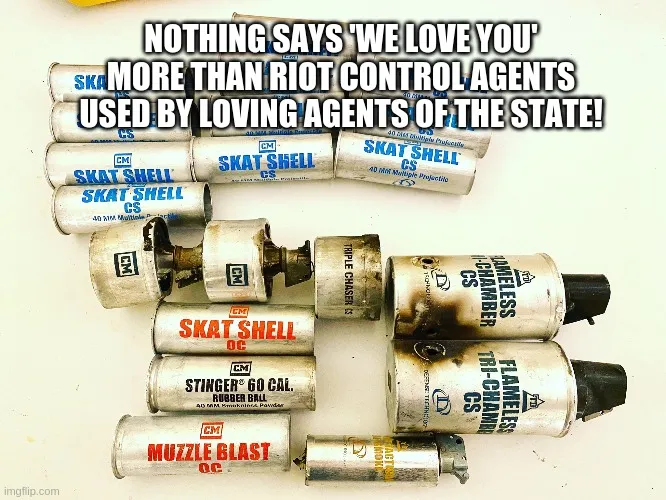I know this may be a little out of date, but I don't think the excitement is quite over just yet.
As a Survivalist one needs to prepare ahead of being called into the game for real.
This article will help you defend your block against those that will injure you to stay in power.
If the ones that kill you to stay in power come, that is a different article entirely.

A Demonstrator’s Guide to Understanding Riot Munitions
And How to Defend against Them
If there’s one thing that police officers prefer to hitting people with sticks, it’s shooting blunt objects and chemical weapons at people.
Arms manufacturers are constantly developing new ways to assault people from a distance—and taxpayers keep buying new toys for their oppressors.
This article offers an overview of less-lethal projectiles—both chemical weapons and impact munitions.
The police themselves don’t bother distinguishing the two.
We’ll cover chemical weapons like tear gas and pepper spray.
We’ll cover impact weapons like baton rounds, rubber bullets, and pepper-balls.
We’ll cover the systems police use to apply these weapons, including air guns, sprays, grenades, grenade launchers, and shotguns.
We’ll cover the ways that police mark people for arrest—and the ways they probably don’t.
Other articles in this series discuss batons and other police weaponry.
One of the most useful articles to read in conjunction to this one is our “Protocols for Common Injuries from Police Weapons.”
This can be a scary subject.
But remember—their goal isn’t to strike us with plastic bullets or spray us with chemicals.
Their goal is to make us live in fear.
They want us to stay home, disconnected, leaving their authority absolute and unchallenged.
They fail to achieve goal every time we take the streets together.
They fail every time we refuse to let that fear dictate what we do.
In this article, we’ll touch briefly on how to protect ourselves via gas masks, armor, shields, and the like.
Other articles explore those options in detail.
But the chief thing that can protect us against the police is solidarity.
We are the ones who must keep each other safe.
One shield on the front line of a demonstration can protect many people.
One medic willing to treat those in the line of fire can protect many people.
A few people who risk jail time to push the police back can protect many people.
Our best protection against riot munitions is each other.
Courage is not the absence of fear.
It is acting despite fear.
Together, we can overcome fear.
https://nitter.cattube.org/hungrybowtie/status/1344916089436655618

On Standardization and Oversight
We have found no evidence that there is any federal or state oversight of what weapons police are permitted to use to quell civil disturbances.
According to an anarchist lawyer who specializes in this field, each of roughly 18,000 agencies in the US maintains its own use of force guidelines detailing internal standards regarding what its officers can do to people.
We’ve found no body that certifies the chemistry employed in chemical weapons.
Any given chemical weapons manufacturer chooses their own binding agents and chemical additives; it appears there is no easy way to know what chemicals we are being exposed to when police target us with these weapons.
While this shouldn’t cause us to back down and accede to authoritarianism, it’s important to remember that these weapons are only “less lethal” in comparison to live ammunition.
There are only two factors contributing to standardizing these weapons.
The first is that weapons that use existing projectile systems (such as 37mm launchers) are more likely to be widely adopted than oddball systems that require entirely new training and weaponry.
The second is that manufacturers tend to copy each other’s innovations.
While the federal government apparently does not provide oversight, it does occasionally offer advice and suggestions—for example, in this somewhat-outdated 2004 manual of less-lethal weaponry.
This article goes on at some length.
Better you get prepared now, iyam.

